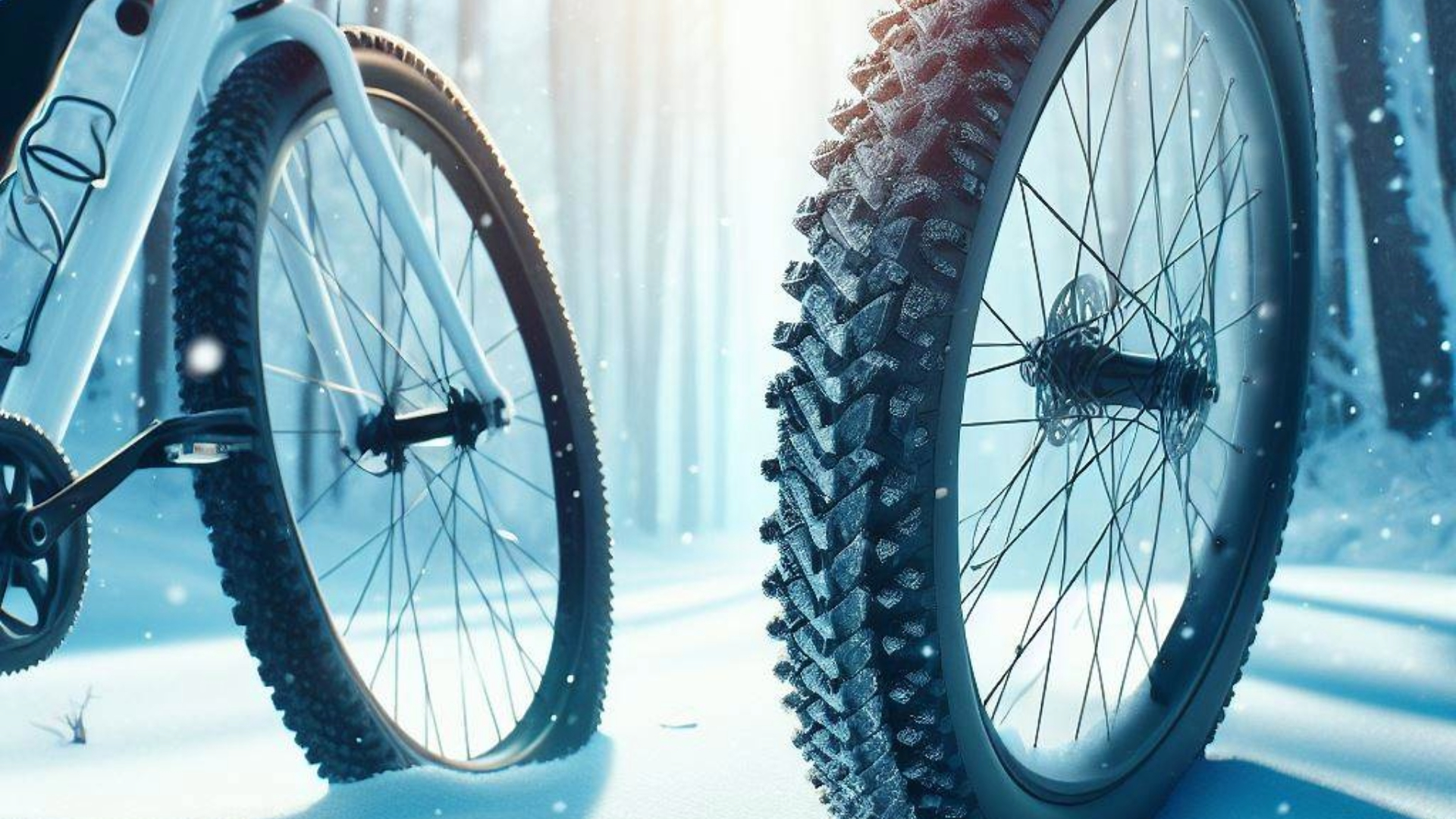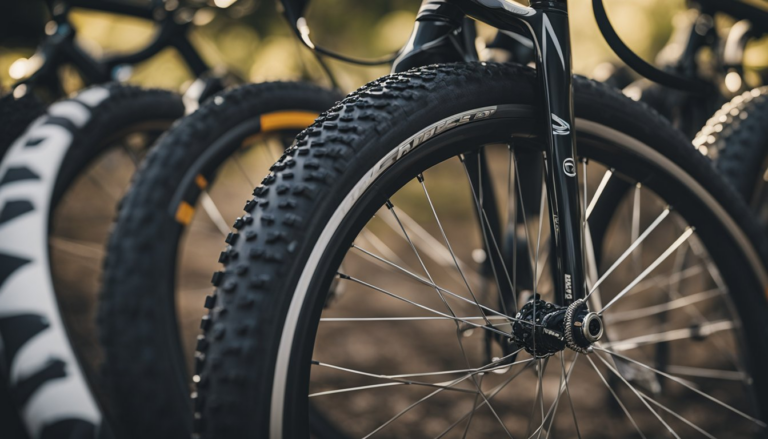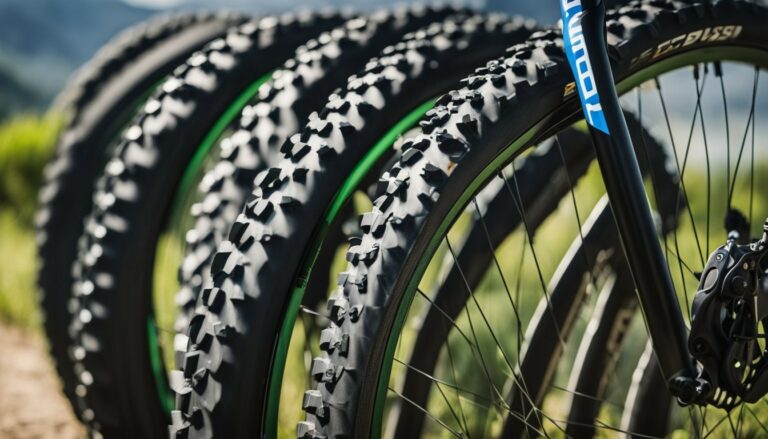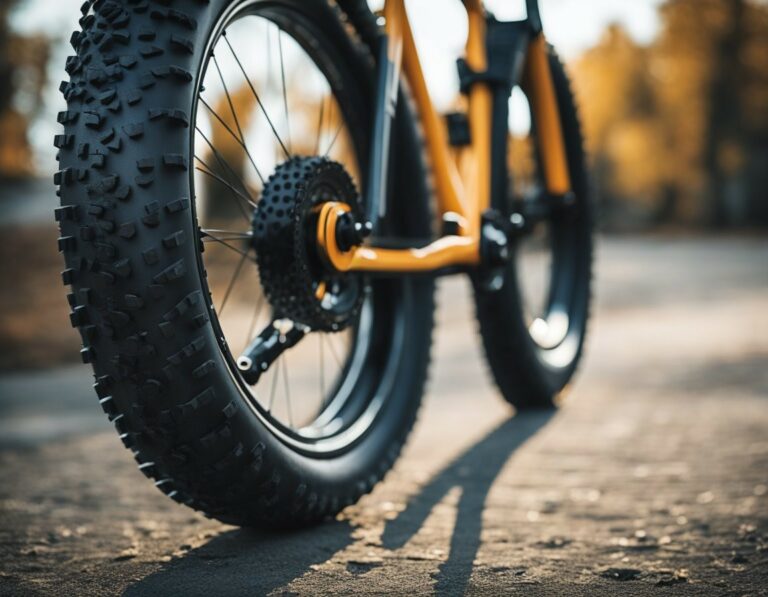Guide to Winter Bike Tires: Choosing the Best for Safe Cycling
As temperatures drop and roads become slippery with ice and snow, it’s important to have the right tires that provide stability and control for a comfortable and safe ride.
This guide will introduce you to winter bike tires, their advantages, and how to choose the right ones for your needs.
Selecting appropriate winter bike tires depends on factors such as the type of bike you own, the terrain you’ll be riding on, and personal preferences in terms of traction and performance.
There are plenty of different options available, including studded tires for extra grip and airless tires that eliminate the risk of flats, so understanding the different features and benefits of each type will help you make an informed decision and enjoy your winter cycling experience.
Key Takeaways
- Winter bike tires are necessary for improved traction and safety in cold, icy conditions.
- Choosing the right tires depends on bike type, terrain, and personal preferences.
- Understanding tire features, installation, and maintenance can enhance your winter biking experience.
Understanding Winter Bike Tires
Types of Winter Bike Tires

Winter bike tires are specifically designed to provide optimal grip, traction, and control on cold, icy, or snow-covered surfaces.
There are three main types of winter bike tires: studded tires, fat bike tires, and winter-specific tread patterns.
Studded Tires: When and Why They’re Necessary Studded tires have metal or carbide studs embedded in the tread to provide extra grip on icy surfaces. These tires are ideal for riding in extreme winter conditions where ice is prevalent. They may not be necessary if you don’t encounter ice regularly.
Fat Bike Tires: Conquering Snow and Slush Fat bike tires are designed with a wide contact patch and low pressure to “float” over snow and slush, providing increased stability and traction. These tires are ideal for deep snow and soft, slushy conditions.
Winter-Specific Tread Patterns: The All-Around Option Winter-specific tread patterns offer a versatile option for a range of winter weather conditions. These tires often feature a blend of aggressive lug patterns and siping, providing traction on a variety of surfaces, including snow, slush, and wet pavement.
| Tire Type | Best For | Key Features |
| Studded Tires | Extreme ice and hardpack snow | Metal or carbide studs for grip on ice |
| Fat Bike Tires | Deep snow and slush | Wide contact patch for stability in soft conditions |
| Winter Tread | Various winter conditions | Aggressive lug patterns and siping for versatile traction |
Features of Winter Bike Tires
- Tread Patterns: Design and Purpose Tread patterns in winter bike tires are designed to improve grip, shed snow and slush, and maintain control in wintry conditions. Large, aggressive lugs provide grip on loose terrain, while siping (small cuts in the lugs) helps with traction on wet or icy surfaces.
- Stud Material and Configuration: Steel vs. Carbide The material and configuration of studs in studded tires impact their performance and durability. Steel studs are economical, but wear more quickly than carbide studs. Carbide studs, while more expensive, offer increased longevity and better grip on ice.
- Tire Width and Pressure: Finding the Sweet Spot The width and pressure of winter bike tires play an important role in achieving optimal grip and performance. Wider tires offer more contact area with the surface, increasing traction on loose or soft terrain. Lower tire pressures allow the tire to conform better to irregular surfaces, further enhancing grip and stability.
- Rubber Compounds: Why They Matter in the Cold Winter bike tires often feature special rubber compounds designed to maintain their grip and flexibility in cold temperatures. Standard rubber compounds can become less pliable in the cold, reducing grip and performance. By using compounds specifically formulated for cold weather, winter tires provide better traction and control.
The Advantages of Winter Bike Tires
Winter bike tires offer improved safety, control, and stability for cyclists navigating through seasonal challenges such as snow and ice.
Benefits of Using Winter Bike Tires
Safety: How the Right Tires Can Save Your Ride One key benefit of winter bike tires is the increased safety they provide. Thanks to their carefully crafted rubber compounds and tread patterns, these tires offer considerable improvements in grip and traction. This is particularly important when cycling in winter conditions where surfaces can become slippery from snow or ice.
A good example of a reliable winter tire brand is Schwalbe, known for its performance in challenging conditions, helping to prevent accidents and ensure a safer ride.
Grip and Traction: The Science of Staying Upright Winter bike tires typically feature a softer rubber compound that remains more flexible in cold temperatures, allowing them to maintain better contact with the ground.
Many also have aggressive tread patterns and may even use studs for additional grip on icy surfaces. This improved grip and traction are needed for maintaining stability and control, especially when cornering or climbing hills on mountain bikes in snowy conditions.
Control and Stability: Mastering Winter Terrain Aside from their enhanced grip, winter bike tires also provide improved control and stability on various winter terrains. Their specialized tread designs channel snow and slush away from the tire’s contact patches, ensuring optimal grip and preventing the wheel from slipping.
This enables cyclists to confidently navigate through even the most challenging winter landscapes, further enhancing the advantages of using winter bike tires in snow and icy conditions.
By opting for appropriate winter bike tires, cyclists can enjoy the benefits of increased safety, superior grip and traction, and enhanced control and stability in a variety of winter terrains. This combination of features ensures a more enjoyable and secure winter cycling experience, making winter bike tires an must-have investment for any serious cyclist.
Installing and Maintaining Your Winter Bike Tires
Installation Tips
When it comes to installing winter bike tires, selecting the appropriate width and type is required. Studded tires, for example, are great for icy conditions as they offer increased traction. Here’s a step-by-step guide to installing studded tires that can help you easily install and secure them on your bike.
In terms of tire width, wider tires tend to perform better in snowy conditions, providing better stability and control. The appropriate tire width may vary depending on your bike model and riding preferences.
Maintenance and Care

Tire Pressure Tips for Cold Weather Riding
Maintaining proper tire pressure is required for winter rides, as it affects both the ride quality and puncture protection. In cold weather, tire pressure tends to drop, so it’s important to check and adjust it regularly.
Generally, slightly lower pressure can help maximize traction on slippery surfaces, but be careful not to reduce it too much, as this may lead to pinch flats or damage to the rim.
Knowing When to Make the Switch to Winter Tires
A good rule of thumb is to switch to winter tires when temperatures begin to dip below freezing. This will ensure you have ample time to become used to the feel and handling of your winter tires before the harsher weather sets in.
Routine Cleaning and Care for Longevity
Winter tires require proper care and cleaning to extend their lifespan. Regularly cleaning your tires after rides prevents the buildup of mud, salt, and debris that can damage the rubber over time. Also, make sure to store your tires in a cool, dry place when not in use.
Inspecting for Stud Loss and Wear
It’s necessary to regularly inspect your winter tires for stud loss and signs of wear. Studded tires, in particular, can lose studs over time due to abrasion on hard surfaces or impacts. Replacing lost studs is important to maintain traction, especially on icy surfaces.
The Importance of Tire Rotation
Tire rotation is an important activity of winter bike tire maintenance. Since both the tread and studs can wear unevenly, regularly rotating your tires (front to back, and vice versa) can help balance the wear and prolong the life of your tires. Track your tire usage and swap them when noticeable differences in wear appear.
| Maintenance Aspect | Tip | Reason for Importance |
| Tire Pressure | Check and adjust regularly in cold weather | Affects ride quality and puncture protection |
| Cleaning and Storage | Clean after rides, store in cool, dry place | Prevents damage and extends tire lifespan |
| Stud Inspection | Regularly check for stud loss and wear | Ensures continued traction on ice |
| Tire Rotation | Rotate to balance wear | Prolongs tire life and maintains performance |
Staying Safe While Riding in Winter

Adjusting Your Riding Style
Winter cycling requires some adjustments to your riding style to maintain safety and confidence. Riding slower and maintaining a more upright position will improve your balance and help you navigate slippery surfaces. When turning, lean the bike, but not your body, to maintain contact with the ground.
In snowy conditions, it’s important to ride smart by maintaining speed and momentum. This will help you keep moving and prevent you from getting stuck. Another thing is, when braking, use both the front and rear brakes gently to avoid locking the wheels and skidding.
Safety Considerations
To ensure puncture resistance, consider using wider, studded tires designed for winter cycling. These tires will provide better traction and stability, making it easier to navigate slippery surfaces, while also reducing the risk of punctures.
Visibility is required during winter months, as days are shorter and weather conditions can reduce overall visibility. Invest in reflective gear for both you and your bike, as well as high-quality bike lights, to increase your visibility to others on the road.
Appropriate winter cycling apparel will not only keep you warm but also protect you from the elements. Necessary items include layered clothing, waterproof jackets and pants, insulated gloves, and winter cycling shoes or shoe covers.
When cornering on slippery surfaces, avoid sudden or sharp movements. Approach turns cautiously and gradually increase the angle of your turn. Keeping your weight centered over the bike will help you maintain control.
Staying safe while riding in winter requires adjustments to your riding style, the use of appropriate gear, and heightened awareness of your surroundings. By following these guidelines, you can confidently navigate the challenges of winter cycling and enjoy the beauty of the season.
Alternatives and DIY Solutions

Alternatives to Winter Tires
While winter bike tires are designed to provide better traction and control in snowy and icy conditions, there are other options cyclists can consider when the temperature begins to drop.
One option is sticking with summer tires, especially if the bike lanes in your area are regularly maintained and cleared of ice and snow. Keep in mind, however, that summer tires may have their limitations in extreme weather conditions.
For those who want to avoid the cost of investing in specialized winter tires, converting their existing tires into “tubes” or “tubeless” options can provide increased traction.
Some cyclists may prefer the familiarity and feel of their regular tires, making these alternatives more appealing. It is important to weigh the benefits against any potential safety risks and consider additional training in winter cycling safety.
When encountering deeper snow, consider the use of snow tires or even tire chains or covers. These can provide added traction and stability in extreme winter conditions, allowing cyclists to navigate through snow and ice with greater confidence.
When to consider tire chains or covers will depend on the weather conditions, but they can be a great option for those living in areas with heavy snowfall or frequent ice storms.
DIY Traction Methods: Are They Worth It?
For some cyclists, do-it-yourself solutions may be a tempting option for increasing tire traction during winter months. While it is possible to create makeshift winter bike tires using materials such as screws, zip ties, or even duct tape, the effectiveness and safety of these solutions should be carefully considered.
One of the main concerns with DIY traction methods is the reliability and durability of the solution. Winter conditions can be unpredictable, and a poorly executed DIY solution could fail at a serious moment.
Another concern is, there may be limitations to the overall performance of these makeshift methods, and they may not provide the same level of traction and control as dedicated winter tires or chains.
Even with these potential drawbacks, some cyclists have found success with DIY solutions. If you decide to explore this option, do so with caution and make sure that safety is your top priority.
Always wear a helmet and other protective gear when cycling in winter, and practice adequate winter cycling techniques to ensure optimal control on slippery surfaces.
Frequently Asked Questions

What are the best tires for cycling in winter conditions?
Winter cycling demands tires that offer enhanced grip and traction on snow and ice. Studded tires are a popular choice, as they provide better control in slippery conditions. Many winter cyclists also opt for tires with deeper treads to improve traction on various winter surfaces.
How do tubeless winter bike tires compare to regular ones?
Tubeless winter bike tires have various benefits over regular tires. They can run at lower air pressure, which can provide better traction on icy or snowy roads. Also, tubeless tires are less prone to punctures as they don’t have an inner tube that can be pinched or damaged by debris.
What do tire sizes like 700×32 mean for winter tires?
Tire sizes are represented in the format of diameter x width. In the case of a 700×32 winter tire, the diameter is 700 millimeters, and the width is 32 millimeters. Winter tires, in general, should be wider than regular tires to improve traction and stability on slippery surfaces.
What can you expect from popular brands like Schwalbe and Continental?
Popular tire manufacturers like Schwalbe and Continental are recognized for their high-quality, innovative, and durable winter bike tires. Both companies offer a wide range of winter tires in different sizes and tread patterns. Schwalbe and Continental have options for various winter conditions, including studded and non-studded tires, ensuring a selection that meets your cycling needs.
Do all-weather road bike tires handle snow and ice well?
All-weather road bike tires offer some level of performance in wet and cold conditions, but they may not be ideal for winter cycling. These tires are designed to provide a balance between wet and dry street conditions, whereas winter-specific tires prioritize traction on snow and ice and may offer better performance and safety during winter months.
Is investing in specific winter bike tires worthwhile?
Investing in winter bike tires can significantly improve your safety and comfort while cycling in snowy and icy conditions. They offer better control, grip, and traction than standard or all-weather tires and can prevent accidents caused by slipping and sliding on frozen surfaces. Ultimately, if you plan to cycle frequently during winter months, investing in winter bike tires is a sensible choice for enhancing your cycling experience.







